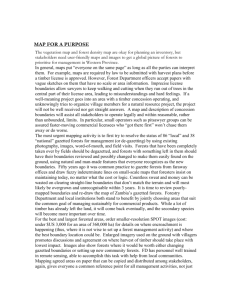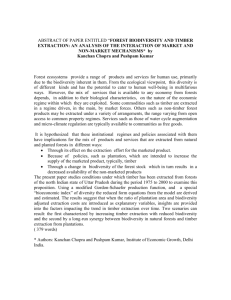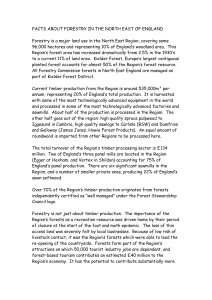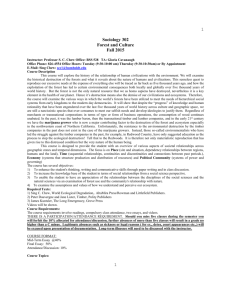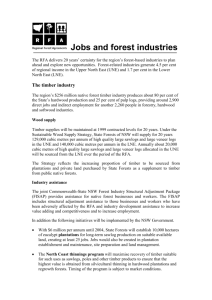the development of the forest resources of sri lanka
advertisement
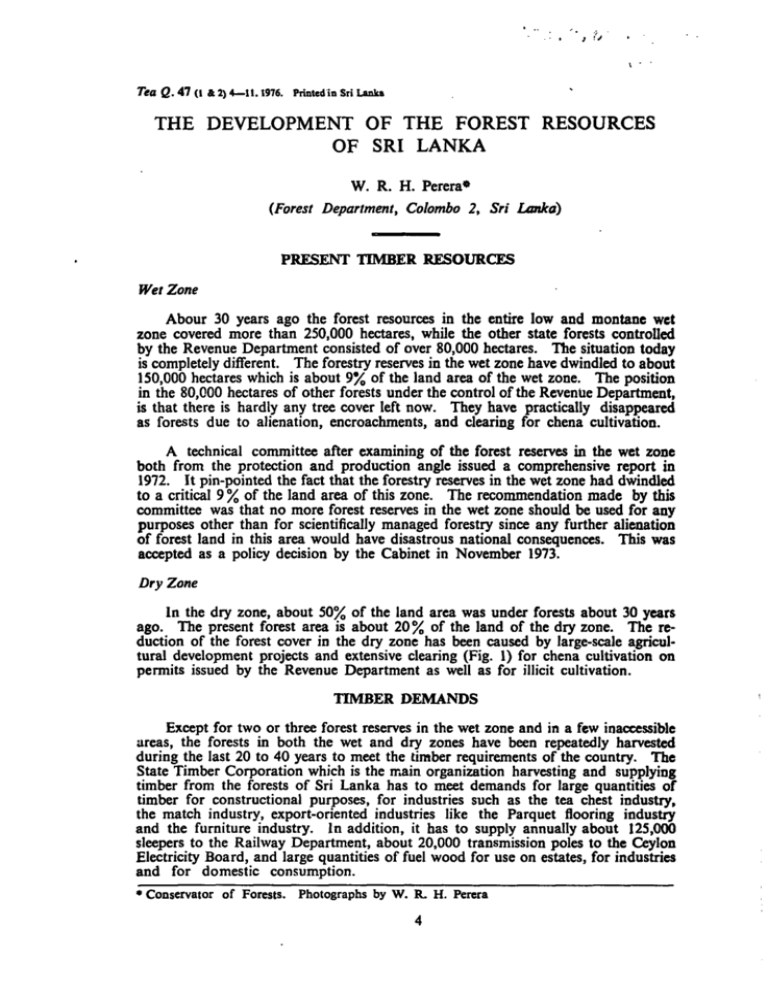
Tea Q. 47 (1 & 2) 4—11.1976. Printed in Sri Lanka THE DEVELOPMENT OF THE FOREST RESOURCES OF SRI LANKA W. R. H. Perera* (Forest Department, Colombo 2, Sri Lanka) PRESENT TIMBER RESOURCES Wet Zone Abour 30 years ago the forest resources in the entire low and montane wet zone covered more than 250,000 hectares, while the other state forests controlled by the Revenue Department consisted of over 80,000 hectares. The situation today is completely different. The forestry reserves in the wet zone have dwindled to about 150,000 hectares which is about 9% of the land area of the wet zone. The position in the 80,000 hectares of other forests under the control of the Revenue Department, is that there is hardly any tree cover left now. They have practically disappeared as forests due to alienation, encroachments, and clearing for chena cultivation. A technical committee after examining of the forest reserves in the wet zone both from the protection and production angle issued a comprehensive report in 1972. It pin-pointed the fact that the forestry reserves in the wet zone had dwindled to a critical 9 % of the land area of this zone. The recommendation made by this committee was that no more forest reserves in the wet zone should be used for any purposes other than for scientifically managed forestry since any further alienation of forest land in this area would have disastrous national consequences. This was accepted as a policy decision by the Cabinet in November 1973. Dry Zone In the dry zone, about 50% of the land area was under forests about 30 years ago. The present forest area is about 20% of the land of the dry zone. The re­ duction of the forest cover in the dry zone has been caused by large-scale agricul­ tural development projects and extensive clearing (Fig. 1) for chena cultivation on permits issued by the Revenue Department as well as for illicit cultivation. TIMBER DEMANDS Except for two or three forest reserves in the wet zone and in a few inaccessible areas, the forests in both the wet and dry zones have been repeatedly harvested during the last 20 to 40 years to meet the timber requirements of the country. The State Timber Corporation which is the main organization harvesting and supplying timber from the forests of Sri Lanka has to meet demands for large quantities of timber for constructional purposes, for industries such as the tea chest industry, the match industry, export-oriented industries like the Parquet flooring industry and the furniture industry. In addition, it has to supply annually about 125,000 sleepers to the Railway Department, about 20,000 transmission poles to the Ceylon Electricity Board, and large quantities of fuel wood for use on estates, for industries and for domestic consumption. • Conservator of Forests. Photographs by W. R. H. Perera 4 The total quantity of timber harvested and sold annually by the State Timber Corporation is over 250,000 m , 40 to 50% of this quantity being in the form of fuel wood. This means that about 200-300 lorry loads of timber are transported daily, under cover of permits, to meet the requirements of the consumers who are supplied by the State Timber Corporation. In addition, the richest blocks of forests in the Southern Region of the wet zone, namely, the Kaneliya, Dediyagalla, Nakiyadeniya complex of forests of about 12,000 hectares was handed over to the Ceylon Plywoods Corporation for harvesting of timber by a decision of the Cabinet made in 1968. The entire quantity of timber exploited by the Plywoods Corporation from this group of forests, is utilised or sold entirely by the Ceylon Plywoods Corporation. In addition, some timber in various forms from sources other than the State Timber Corporation or the Ceylon Plywoods Corporation is sold to consumers. 3 It should be emphasised that while meeting these timber demands, the natural forests (except those being cleared for development) as well as the gradually in­ creasing plantations of forest on estates have to be carefully husbanded in the in­ terests of soil and water conservation and the general shaping of the environment. FOREST DEVELOPMENT PLAN The Forest Department is now implementing a large-scale re-foresting pro­ gramme of over 7,500 hectares per year within the framework of the long-term forestry development plan drawn up in 1970. This programme is designed to increase production as well as to re-shape the environment which has suffered due to the clearing of forests which— (a) have necessarily got to be cleared for agricultural development: (6) have been heavily degraded over the years to meet the timber demands of the country; (c) . have been cleared for chena cultivation or have been encroached upon; and (d) to prevent further encroachments into forestry reserves. Dry Zone Re-forestation In the dry zone a forest plantation has a timber potential of about 40 times that of the presently degraded secondary forests of the dry zone. The indigenous species of the dry zone, like Ebony, Satin and Palu are extremely slow-growing and takes 10 to 20 years to be established when planted. This means that if planted in a pure stand, they will have to be maintained, incurring heavy expenditure up to about the 20th year. It would take from 150-250 years to produce matured large-size timber. In comparison, very valuable fast-growing exotics like Teak, establish themselves in two to three years. (Figs. 1 & 2). Small size timber can be obtained from thin­ nings in 15 to 20 years while large matured trees could be harvested in 40 to 60 years depending on the site of planting. Teak and other exotics being gregarious species in this natural habitat, are therefore silviculturally more suited for raising in pure stands as plantations, unlike local indigenous species. (Fig. 3). Taking all these factors into consideration, over 4,000 hectares of Teak,, and about 400 hectares of Eucalyptus camaldulensis are planted every year under the co­ operative re-forestation system in the dry zone. Under this system, food crops 5 are inter-cultivated-in between the rows of Teak for a period-of up to 3 years till the Teak gets established. (Fig. 4). -Up to 1976, about. 60,000 hectares of Teak plantations have already been established in the dry zone, over 60% of these plan­ tations having been established in the last eight years. Wet Zone Re-forestation The long-term policy objective of the Forest Department in the wet zone is to carry out a selective harvesting of timber and to conserve a major part of the wet zone natural forests, more as 'protection' forests rather than as 'production' forests. Completely denuded lands, heavily degraded forests, as well as protective belts of natural forests which may form protective zones against encroachers are also taken up for re-forestation. In this zone too the local indigenous species are extremely slow-growing and would take as much as 80 to 150 years or more to mature. Re-forestation is, there­ fore, carried out with fast-growing exotics which establish themselves in two to four years and could be harvested in 10 to 50 years, depending on the ultimate objective of utilisation of the timber (i.e., whether it is needed for pulp, fuel wood, transmission poles, the match industry, as constructional timber or as sleepers). The main species planted in the wet zone are Pinus caribaea (Figs. 5 & 6), Pinus patula, Albizia molu- cana, Eucalyptus spp. (Figs. 7 & 8), Alstonia macrophylla, Cupressus spp. and Mahogany. About 1,200 hectares of Pines are planted annually together with 200 hectares of Albizia, 200 hectares of Eucalyptus spp., small acreages of Alstonia, Cupressus spp. and about 800 hectares of enriched land with Mahogany. TIMBER POTENTIAL IN THE FOREST PLANTATIONS In addition to the forest plantations, large extents of natural forests in both the dry and wet zones including about 2,000 hectares in Sinharaja, are being demarcated and preserved as 'man and biosphere' reserves for preserving the ecosystem and also to act as gene pools. The 1,200 hectares of Pines are being raised annually to meet both the current as well as the future demands of long fibre pulp for the paper industry in Sri Lanka. At present, over Rs. 100 million worth of pulp is required annually for the paper industry. Pine timber is also a high-quality timber for constructional purposes, for furniture and for the chip-board industry. The real impact of the re-forestation programme, from the point of view of production would be felt only from about ten years onwards, because over 80% of the present plantations are under ten years of age. The output of timber from plan­ tations would gradually increase considerably from the present level of about 4060,000 m per year. It is estimated that in about 25 years' time the timber that could be harvested annually from the forest plantations would be about 560,000 m cu. ft. of Teak, 42,500 m of Albizia, 85,000 m of Eucalyptus and the equivalent about 140,000 m of Pines, totalling, nearly 850,000 m of timber other than fuel wood. This compares with 110,000-140,000 m of timber other than fuel wood, from the forests of Sri Lanka that are being harvested today. 3 3 3 3 3 3 3 It is therefore imperative that until such time as the plantations raised by the Forest Department and those planted by estates and other organizations can be 6 Fig 1—An area in the dry zone cleared for reforestation FIG. 2—The same area as shown in Fig. I three years after planting teak FIG. 5 - / 4 Mature pine plantation FiG- 7—A plantation of Eucalyptus grandis 10 brought into full production on a scientifically-managed basis, both the natural and the plantation forests should be carefully husbanded. This is necessary in the interests of the environment especially for conserving our water resources in the wet zone which forms the catchment of all the major rivers in the country, particularly the Mahaweli. The most critical period during which these forest resources will have to be care­ fully conserved would be the next ten years till the plantation forests starts yielding their timber on a scientifically-managed basis. If we fail to do this the consequen­ ces to the country and for future generations will be disastrous. FIG. 8—Eucalyptus plantations in the highlands Accepted for Publication—17th March, 1977. 11
